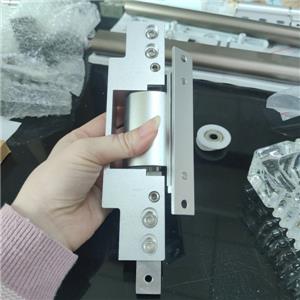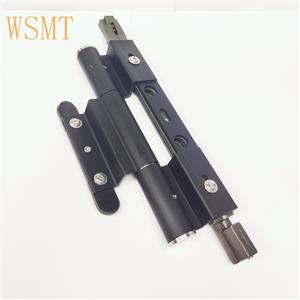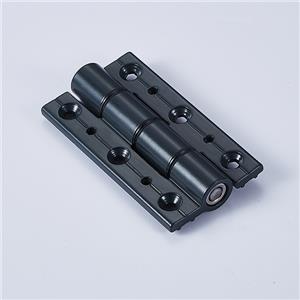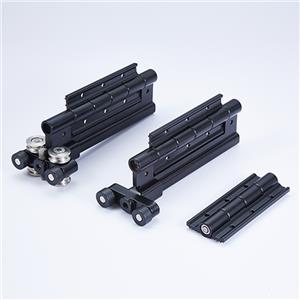Aluminium Handles: Where Function Meets Design in Modern Architecture
When you think about doors and windows, you might not immediately think about the handle. But this small component plays a surprisingly big role in how we interact with our spaces. From the moment you open a front door to the touch of a sliding glass panel, a well-designed aluminium handle combines both form and function — it's the handshake of your home or office.
In today's architecture, where clean lines, durability, and sustainability matter more than ever, aluminium door handles are redefining what it means to have both strength and style. In this article, we'll explore everything about aluminium handles — their materials, finishes, styles, and even the psychology behind their design.
1. The Rise of Aluminium Handles in Modern Design
According to Grand View Research (2024), the global door handle market is valued at over USD 9.3 billion, and aluminium accounts for more than 40% of all materials used. Why? Because aluminium handles strike the perfect balance between aesthetic appeal, durability, and cost-effectiveness.
In modern construction — from minimalist apartments in Singapore to glass-fronted office towers in Dubai — aluminium door handles have become a symbol of modern architecture. They're sleek, corrosion-resistant, and can be crafted into nearly any shape imaginable.
Architects and interior designers prefer aluminium handles for several reasons:
They blend seamlessly with aluminium doors and windows.
They can be anodized or powder-coated to match any color palette.
They are lightweight yet strong, ideal for large panels or folding systems.
They support eco-friendly architecture — aluminium is 100% recyclable.
2. What Makes Aluminium Handles So Popular?
If you look at Google Trends, searches for “aluminium door handle” have grown steadily in the past five years, especially in regions like the Middle East, Southeast Asia, and Europe — markets where aluminium doors and windows dominate construction projects.
So what makes them so desirable?
✅ Durability
Aluminium naturally forms a thin oxide layer that protects it from rust and corrosion, even in humid or coastal climates. This is one reason why aluminium handles last far longer than zinc or iron alternatives.
✅ Design Flexibility
Aluminium can be extruded, cast, or machined into countless forms — from bold geometric shapes to ultra-slim contemporary profiles. Designers love the freedom it offers.
✅ Lightweight Strength
Despite being 60% lighter than steel, aluminium offers impressive tensile strength, making it ideal for handles on aluminium doors that see daily use.
✅ Low Maintenance
Unlike brass or steel handles that tarnish or need polishing, aluminium requires minimal upkeep — just a gentle wipe with a damp cloth keeps it looking new.
3. Common Types of Aluminium Handles
Depending on the type of door or window, the aluminium handle can vary significantly in shape, size, and functionality. Let’s explore the main categories:
a. Lever Handles
The most common type found in homes and offices. Lever handles made of aluminium are ergonomic and come in both classic and minimalist designs.
b. Pull Handles
These are typically seen on sliding doors, glass entryways, or commercial entrances. Aluminium pull handles give a sense of strength and symmetry.
c. Recessed Handles
Ideal for bifold and sliding doors, these handles sit flush with the surface, maintaining a clean, streamlined look.
d. Locking Handles
A hybrid option combining handle and locking mechanisms, commonly used on patio doors or balcony access systems.
e. Custom Handles
High-end projects often feature bespoke aluminium door handles — tailored to match the exact tone, texture, or curvature of the architectural design.
4. The Material Advantage: Why Aluminium Beats the Rest
To understand why the aluminium handle stands out, let’s compare it with other materials used in handle manufacturing:
| Material | Weight | Corrosion Resistance | Finish Variety | Recyclability | Cost Efficiency |
|---|---|---|---|---|---|
| Aluminium | Very Light | Excellent | High | 100% | High |
| Stainless Steel | Heavy | Excellent | Medium | 70% | Medium |
| Brass | Medium | Moderate | Low | 60% | Low |
| Zinc Alloy | Light | Fair | Medium | 60% | High |
As seen above, aluminium wins in almost every key category — which explains why it’s become the material of choice for door and window handle production worldwide.
5. Design and Finishing: Where Art Meets Engineering
One of the greatest appeals of aluminium handles lies in their surface finishes. The finish not only defines how the handle looks but also how it feels to touch — a critical factor for user experience.
Some of the most popular finishes include:
Anodized Finish: Enhances corrosion resistance while giving a soft, metallic sheen. Common in matte silver or black.
Powder Coating: Offers endless color options — from pure white to bronze and champagne.
Brushed Finish: Gives a textured, satin-like look, popular in minimalist interior styles.
Polished Finish: Shiny and smooth, often seen in high-end residential projects.
The finish also affects fingerprint resistance, surface grip, and cleaning frequency — all practical considerations when choosing the right handle for aluminium doors.
6. How Aluminium Handles Contribute to Modern Architecture
Modern design philosophy emphasizes simplicity, functionality, and sustainability — three things aluminium handles embody perfectly.
A report by ArchDaily (2023) highlights how minimalism in design has influenced the rise of hardware elements that “blend rather than dominate.” The aluminium door handle fits this philosophy — it's sleek, neutral, and enhances the geometry of modern doors and windows without drawing too much attention.
Furthermore:
Aluminium handles complement the rise of frameless glass doors and bifold systems.
They allow smooth operation with minimal friction.
Their modular designs support both residential and commercial applications.
7. Sustainability and Recycling
Aluminium's sustainability story is unmatched. According to the Aluminium Association (2024), over 75% of all aluminium ever produced is still in use today — a staggering figure that highlights its recyclability.
Using aluminium handles supports green building certifications like LEED and BREEAM, as the production process consumes up to 90% less energy when recycled aluminium is used instead of virgin material.
For architects and builders focused on eco-conscious construction, specifying aluminium door handles is a small yet significant contribution to environmental responsibility.
8. Trends in Aluminium Handle Design
The modern aluminium handle is evolving beyond function — it's becoming a design statement. Let's look at a few emerging trends:
Matte Black and Dark Bronze Finishes: These have become popular in luxury interiors for their bold contrast with light walls or glass panels.
Hidden Handles: Especially in bifold doors, concealed aluminium handles create a smooth surface with no protruding parts.
Ergonomic Design: Handles shaped for comfort and ease of use, important in offices and hospitality spaces.
Smart Handles: Integration of electronic locks and motion sensors into aluminium housings for smart home compatibility.
These trends not only enhance visual appeal but also improve user experience, blending aesthetics with technology.
9. Maintenance and Longevity
One of the biggest advantages of aluminium handles is their longevity. A high-quality aluminium handle can last over 15 years with minimal maintenance.
Here's how to keep them looking and working like new:
Wipe handles weekly with a damp cloth to remove dust.
Avoid using harsh chemicals or abrasive pads.
If anodized, clean with a pH-neutral cleaner to preserve the oxide layer.
Lubricate the mechanism annually if it includes a lock system.
These easy steps ensure your handle for aluminium door remains smooth and secure for years.
10. Market Insights and Growth Forecast
The demand for aluminium door handles continues to grow. Based on data from MarketsandMarkets (2024), the global aluminium hardware industry is expected to reach USD 22.4 billion by 2030, growing at a CAGR of 5.8%.
Key growth drivers include:
The boom in urban housing projects across Asia and the Middle East.
The shift toward energy-efficient aluminium windows and doors.
The demand for customized handle solutions in architectural design.
These market insights show that the aluminium handle is more than a product — it's part of a larger movement toward sustainable and modern living.
11. Choosing the Right Aluminium Door Handle
Here's a quick checklist when selecting your next aluminium handle:
Match the door type: Use lever handles for swing doors, pull handles for sliding doors, and recessed handles for bifolds.
Consider the finish: Matte finishes are modern and practical; polished ones suit classical designs.
Think ergonomically: The handle should feel natural in your grip.
Color coordination: Match or contrast with the door frame and wall.
Quality assurance: Choose handles with solid machining and corrosion-resistant coating.
A good handle for aluminium door is not just an accessory — it's a daily touchpoint that defines your space's comfort and functionality.
12. The Future of Aluminium Handles
The next decade will see aluminium handles becoming even more integrated into smart homes and intelligent building systems. Designers are already experimenting with biometric locks, touchless entry systems, and AI-controlled mechanisms built into aluminium hardware.
Additionally, as architects continue to prioritize sustainability and user experience, the role of aluminium handles will evolve from simple hardware to essential components of interactive design.
13. Final Thoughts
At first glance, a handle for aluminium door might seem like a small detail. But as modern design increasingly focuses on user experience and sustainability, this simple piece of hardware becomes a statement of innovation and quality.
Aluminium handles bring together all the right elements — lightness, strength, elegance, and environmental consciousness. Whether you're designing a luxury villa, a commercial tower, or a minimalist studio, the humble aluminium handle ensures every door opens with purpose and style.
WSMT supply premium quality aluminium accessories for windows and doors.
Welcome to contact us: whatsapp/Wechat/Zalo+86 150 156 88141
Email:catherine@weisidunwj.com




